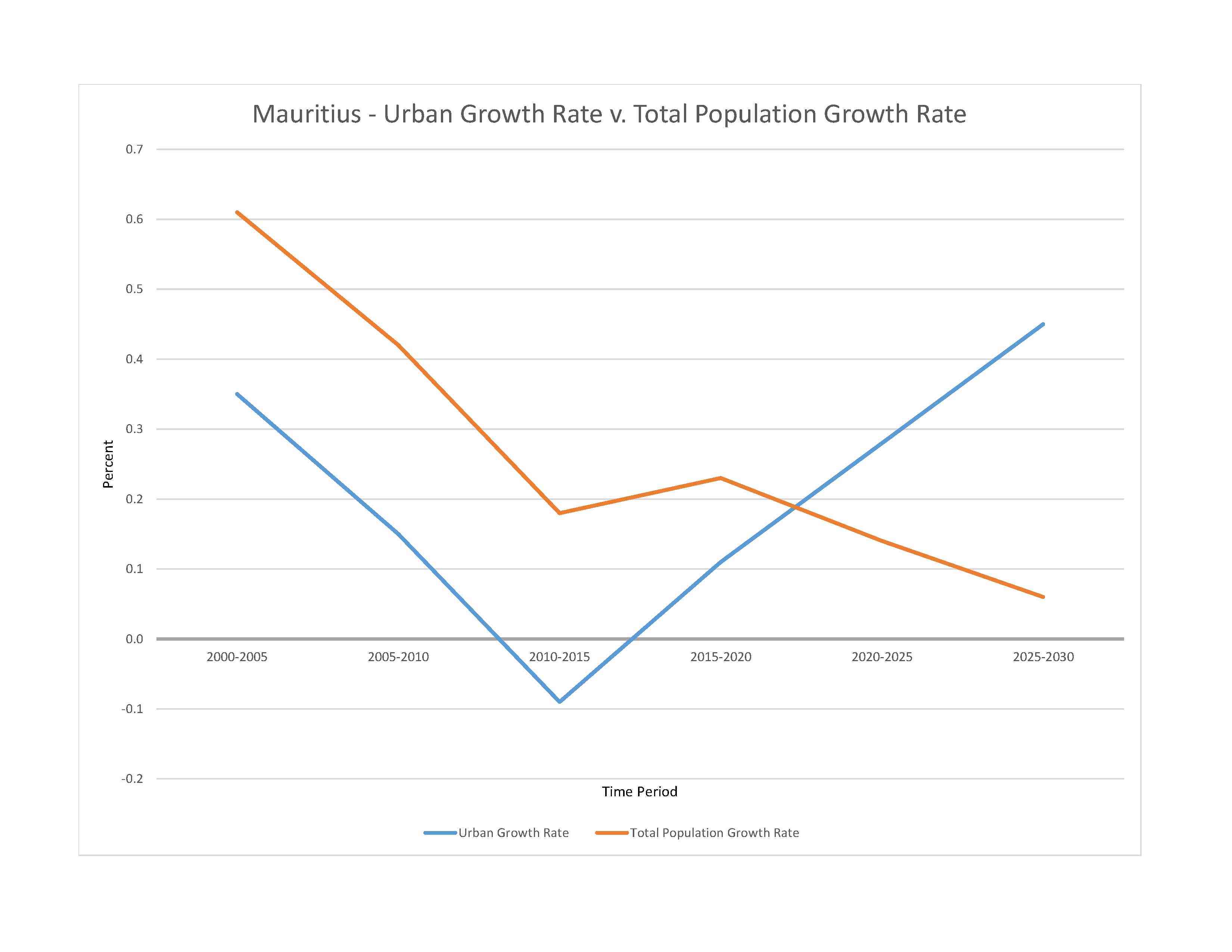
1,309,448 (2023 est.)
noun: Mauritian(s)
adjective: Mauritian
Indo-Mauritian (compose approximately two thirds of the total population), Creole, Sino-Mauritian, Franco-Mauritian
note: Mauritius has not had a question on ethnicity on its national census since 1972
Creole 86.5%, Bhojpuri 5.3%, French 4.1%, two languages 1.4%, other 2.6% (includes English, one of the two official languages of the National Assembly, which is spoken by less than 1% of the population), unspecified 0.1% (2011 est.)
Hindu 48.5%, Roman Catholic 26.3%, Muslim 17.3%, other Christian 6.4%, other 0.6%, none 0.7%, unspecified 0.1% (2011 est.)
Mauritius has transitioned from a country of high fertility and high mortality rates in the 1950s and mid-1960s to one with among the lowest population growth rates in the developing world today. After World War II, Mauritius’ population began to expand quickly due to increased fertility and a dramatic drop in mortality rates as a result of improved health care and the eradication of malaria. This period of heightened population growth – reaching about 3% a year – was followed by one of the world’s most rapid birth rate declines.
The total fertility rate fell from 6.2 children per women in 1963 to 3.2 in 1972 – largely the result of improved educational attainment, especially among young women, accompanied by later marriage and the adoption of family planning methods. The family planning programs’ success was due to support from the government and eventually the traditionally pronatalist religious communities, which both recognized that controlling population growth was necessary because of Mauritius’ small size and limited resources. Mauritius’ fertility rate has consistently been below replacement level since the late 1990s, a rate that is substantially lower than nearby countries in southern Africa.
With no indigenous population, Mauritius’ ethnic mix is a product of more than two centuries of European colonialism and continued international labor migration. Sugar production relied on slave labor mainly from Madagascar, Mozambique, and East Africa from the early 18th century until its abolition in 1835, when slaves were replaced with indentured Indians. Most of the influx of indentured labor – peaking between the late 1830s and early 1860s – settled permanently creating massive population growth of more than 7% a year and reshaping the island’s social and cultural composition. While Indians represented about 12% of Mauritius’ population in 1837, they and their descendants accounted for roughly two-thirds by the end of the 19th century. Most were Hindus, but the majority of the free Indian traders were Muslims.
Mauritius again turned to overseas labor when its success in clothing and textile exports led to a labor shortage in the mid-1980s. Clothing manufacturers brought in contract workers (increasingly women) from China, India, and, to a lesser extent Bangladesh and Madagascar, who worked longer hours for lower wages under poor conditions and were viewed as more productive than locals. Downturns in the sugar and textile industries in the mid-2000s and a lack of highly qualified domestic workers for Mauritius’ growing services sector led to the emigration of low-skilled workers and a reliance on skilled foreign labor. Since 2007, Mauritius has pursued a circular migration program to enable citizens to acquire new skills and savings abroad and then return home to start businesses and to invest in the country’s development.
0-14 years: 15.3% (male 102,335/female 97,955)
15-64 years: 71.35% (male 464,380/female 469,877)
65 years and over: 13.36% (2023 est.) (male 72,026/female 102,875)
total dependency ratio: 40.7
youth dependency ratio: 23.4
elderly dependency ratio: 17.3
potential support ratio: 5.8 (2021 est.)
total: 39.3 years (2023 est.)
male: 37.8 years
female: 40.6 years
0.09% (2023 est.)
9.8 births/1,000 population (2023 est.)
9 deaths/1,000 population (2023 est.)
0 migrant(s)/1,000 population (2023 est.)
population density is one of the highest in the world; urban clusters are found throughout the main island, with a greater density in and around Port Luis; population on Rodrigues Island is spread across the island with a slightly denser cluster on the north coast as shown in this 
urban population: 40.9% of total population (2023)
rate of urbanization: 0.28% annual rate of change (2020-25 est.)

149,000 PORT LOUIS (capital) (2018)
at birth: 1.07 male(s)/female
0-14 years: 1.04 male(s)/female
15-64 years: 0.99 male(s)/female
65 years and over: 0.7 male(s)/female
total population: 0.95 male(s)/female (2023 est.)
84 deaths/100,000 live births (2020 est.)
total: 11.8 deaths/1,000 live births (2023 est.)
male: 13.4 deaths/1,000 live births
female: 10.2 deaths/1,000 live births
total population: 75.1 years (2023 est.)
male: 72.3 years
female: 78.1 years
1.35 children born/woman (2023 est.)
0.65 (2023 est.)
63.8% (2014)
improved: urban: 99.9% of population
rural: 99.8% of population
total: 99.9% of population
unimproved: urban: 0.1% of population
rural: 0.2% of population
total: 0.1% of population (2020 est.)
6.7% of GDP (2020)
2.71 physicians/1,000 population (2020)
3.7 beds/1,000 population (2020)
improved: urban: 99.9% of population
rural: N/A
total: N/A
unimproved: urban: 0.1% of population
rural: N/A
total: (2020 est.) NA
10.8% (2016)
total: 3.39 liters of pure alcohol (2019 est.)
beer: 1.94 liters of pure alcohol (2019 est.)
wine: 0.23 liters of pure alcohol (2019 est.)
spirits: 0.88 liters of pure alcohol (2019 est.)
other alcohols: 0.03 liters of pure alcohol (2019 est.)
total: 20.2% (2020 est.)
male: 37.3% (2020 est.)
female: 3% (2020 est.)
N/A
62% (2023 est.)
4.9% of GDP (2021 est.)
definition: age 15 and over can read and write
total population: 92.2%
male: 93.5%
female: 90.5% (2021)
total: 15 years
male: 14 years
female: 16 years (2017)
NOTE: The information regarding Mauritius on this page is re-published from the 2024 World Fact Book of the United States Central Intelligence Agency and other sources. No claims are made regarding the accuracy of Mauritius 2024 information contained here. All suggestions for corrections of any errors about Mauritius 2024 should be addressed to the CIA or the source cited on each page.
This page was last modified 04 May 24, Copyright © 2024 ITA all rights reserved.